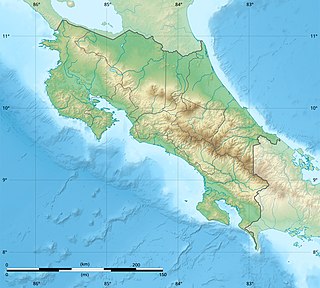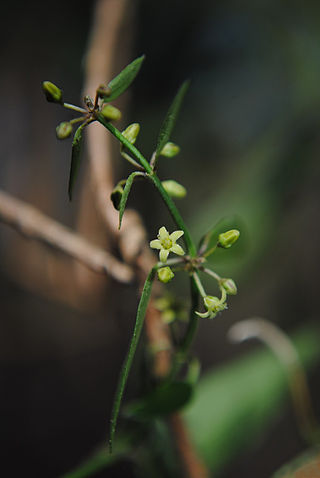
Costa Rica is located on the Central American Isthmus, surrounding the point 10° north of the equator and 84° west of the prime meridian. It has 212 km of Caribbean Sea coastline and 1,016 on the North Pacific Ocean.

Cocos Island is an island in the Pacific Ocean administered by Costa Rica, approximately 550 km southwest of the Costa Rican mainland. It constitutes the 11th of the 13 districts of Puntarenas Canton of the Province of Puntarenas. With an area of approximately 23.85 km2 (9.21 sq mi), the island is more or less rectangular in shape. It is the southernmost point of geopolitical North America if non-continental islands are included.

Oncidium, abbreviated as Onc. in the horticultural trade, is a genus that contains about 330 species of orchids from the subtribe Oncidiinae of the orchid family (Orchidaceae). As presently conceived, it is distributed across much of South America, Central America, Mexico and the West Indies, with one species (O. ensatum) extending into Florida. Common names for plants in this genus include dancing-lady orchid and golden shower orchid.

The wildlife of Costa Rica comprises all naturally occurring animals, fungi and plants that reside in this Central American country. Costa Rica supports an enormous variety of wildlife, due in large part to its geographic position between North and South America, its neotropical climate, and its wide variety of habitats. Costa Rica is home to more than 500,000 species, which represent nearly 5% of the total species estimated worldwide, making Costa Rica one of the 20 countries with the highest biodiversity in the world. Of these 500,000 species, a little more than 300,000 are insects.

Rhipidocladum is a genus of New World woody bamboo in the grass family). It found in Mesoamerica, Trinidad, and South America. The genus is characterized by 1) erect, non-pseudopetiolate culm leaves, 2) numerous branchlets arising in an aspidate (fan-like) array, and 3) fruits being true caryopses. The name is derived from the Greek rhipid meaning "fanlike" and clad meaning "branch".
- Rhipidocladum abregoensis - Colombia
- Rhipidocladum ampliflorum - Venezuela
- Rhipidocladum angustiflorum - Colombia, Venezuela
- Rhipidocladum bartlettii - Mexico, Belize, Guatemala, Honduras
- Rhipidocladum clarkiae - Costa Rica
- Rhipidocladum harmonicum - from southern Mexico to Bolivia
- Rhipidocladum martinezii - Mexico (Chiapas)
- Rhipidocladum maxonii - Costa Rica, Guyana
- Rhipidocladum neumannii - Argentina, Bolivia
- Rhipidocladum pacuarense - Nicaragua, Costa Rica
- Rhipidocladum panamense - Panamá
- Rhipidocladum parviflorum - Venezuela, Colombia, Perú, Bolivia, Brazil, Panamá
- Rhipidocladum pittieri - from Mexico (Michoacán) to Panamá
- Rhipidocladum prestoei - Trinidad
- Rhipidocladum racemiflorum - Mexico from Tucumán to Tamaulipas
- Rhipidocladum sibilans - Venezuela, Guyana

Scaphosepalum is a genus of plants belonging to the family Orchidaceae. The species in this genus are mostly found in Central and South America, with one species extending into southern Mexico. In accordance with their genus name, many species in this genus produce unusual and distinctive flowers; some possessing cushion-like characteristics reminiscent of an African buffalo's horns, others possessing characteristics of snake fangs.
Maquenque Wildlife Refuge, is a protected area in Costa Rica, managed under the Arenal Huetar Norte Conservation Area, it was created in 2005 by decree 32405-MINAE.

The dark long-tongued bat is a species of bat from South and Central America. It was formerly considered the only species within the genus Lichonycteris, but is now recognized as one of two species in that genus, along with the pale brown long-nosed bat. It is small species of bat, with adults weighing 6–11 g (0.21–0.39 oz) and having a total length of 46–63 mm (1.8–2.5 in).

The bronzy hermit is a species of hummingbird in the family Trochilidae. It is found in Colombia, Costa Rica, Ecuador, Honduras, Nicaragua, and Panama.

Ulmus mexicana, the Mexican elm, is a large tree endemic to Mexico and Central America. It is most commonly found in cloud forest and the higher elevations of tropical rain forest with precipitation levels of 2–4 m (79–157 in) per year, ranging from San Luis Potosi south to Chiapas in Mexico, and from Guatemala to Panama beyond. The tree was first described botanically in 1873.

Platymiscium albertinae is a species of plant in the family Fabaceae. It is found only in Honduras. It is threatened by habitat loss.

Platymiscium is a genus of flowering plants in the family Fabaceae, and was recently assigned to the informal monophyletic Pterocarpus clade within the Dalbergieae. It has a Neotropical distribution, from northern Mexico to southern Brazil. Platymiscium is the only genus in the family with opposite leaves in all its species. Its wood has various uses, mostly for constructions and furniture.

Platymiscium gracile is a species of plant in the family Fabaceae. It is found only in Peru.

Astrocaryum alatum is a species of palm with edible nuts, a flowering plant in the family Arecaceae. It is a common species found many types of rainforests and swamps in Honduras, Costa Rica, Nicaragua and Panama.

Minquartia is a monotypic genus of flowering plants in the Olacaceae family containing the single species Minquartia guianensis. It is found in Bolivia, Brazil, Colombia, Costa Rica, Ecuador, French Guiana, Guyana, Nicaragua, Panama, Peru, Suriname, and Venezuela.

Virola surinamensis, known commonly as baboonwood, ucuuba, ucuhuba and chalviande, is a species of flowering plant in the family Myristicaceae. It is found in Brazil, Costa Rica, Ecuador, French Guiana, Guyana, Panama, Peru, Suriname, and Venezuela. It has also been naturalized in the Caribbean. Its natural habitats are subtropical or tropical moist lowland forests, subtropical or tropical swamps, and heavily degraded former forest. Although the species is listed as threatened due to habitat loss by the IUCN, it is a common tree species found throughout Central and South America.

Illicium parviflorum, commonly known as yellow anisetree, yellow-anise, swamp star-anise, and small anise tree, is a species of flowering plant in the family Schisandraceae, or alternately, the Illiciaceae. It is native to Florida in the United States. It historically occurred in Georgia as well, but it has been extirpated from the state.

Trillium albidum is a species of flowering plant in the bunchflower family Melanthiaceae. It is the only trillium characterized by a stalkless white flower. The species is endemic to the western United States, ranging from central California through Oregon to southwestern Washington. In the San Francisco Bay Area, it is often confused with a white-flowered form of Trillium chloropetalum. In northern Oregon and southwestern Washington, it has a smaller, less conspicuous flower.

Orthosia is a genus of plants in the family Apocynaceae, first described as a genus in 1844.
Velva Elaine Rudd was an American botanist, specializing in tropical legumes. She worked as a curator at the Smithsonian Institution's National Museum of Natural History and also conducted research at the herbarium at California State University, Northridge.


















